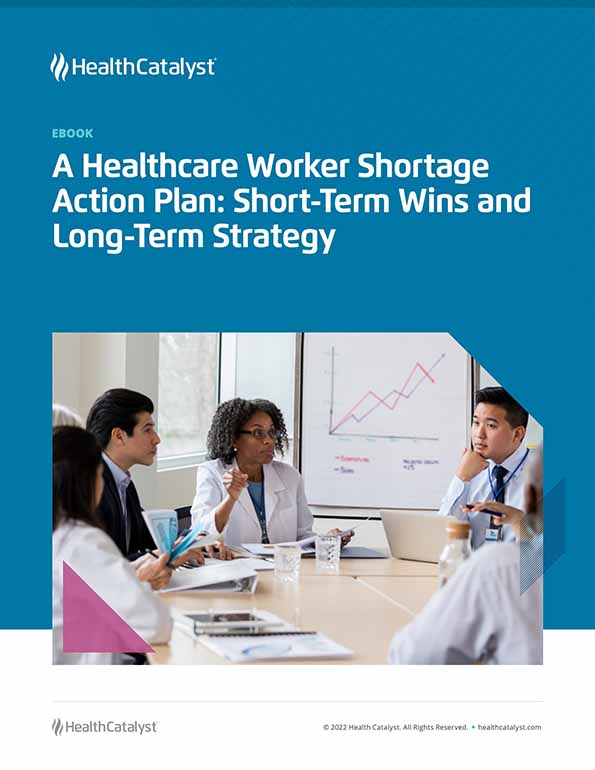U.S. health systems will have a projected deficit of 200,000-450,000 RNs by 2025. Meanwhile, hospital labor costs have reached almost 50% of an organization’s overall expenses. Now more than ever, leaders need a data-driven labor management strategy that ensures the most cost-effective, high-quality care.



Healthcare worker shortages are emerging throughout the industry, from nurses and physicians to pharmacy technicians, home health aides, medical assistants, and more. Projected impacts include a McKinsey estimate of a deficit of 200,000 to 450,000 registered nurses available for direct patient care by 2025, an estimated shortage from the Association of American Medical Colleges of 37,800 to 124,000 physicians by 2034, and Mercer’s projected deficiency of over 3 million more in other healthcare roles.
Drivers of these shortages range from burnout and new opportunities in a changing industry to an aging workforce, unhappiness, and even safety concerns in the workplace. The demands of the COVID-19 pandemic have left many overworked to unsustainable levels. Meanwhile, healthcare professionals are also finding alternatives to the traditional hospital setting, such as lucrative and less intense remote positions. Compounding these issues are reports that healthcare workers feel disrespected and undervalued. Nurses, for example, are predominantly female and underpaid, earning an average of 24% less than men.
While the healthcare worker shortage immediately impacts clinical care, labor challenges are also a systemwide problem, as repercussions such as unsustainable costs and interrupted workflows affect every aspect of an organization. In May 2022, Kaufman Hall reported that hospital labor expenses had increased one-third from pre-pandemic levels, reaching almost 50% of total expenses, including a fivefold increase in contract labor. Due to the heavy financial burden and the complex drivers described above, health systems must leverage quality data and work collaboratively to understand and proactively approach staffing.
Healthcare has a workforce supply problem, with people leaving the profession at a greater rate than they’re entering it. Meanwhile, demand and cost are rising, leaving organizations short on human and financial resources to meet community healthcare needs.
Several significant factors are driving the healthcare supply shortage:
As the workforce supply diminishes, the demand for healthcare services is growing. After a COVID-19-driven slowdown in patient volumes in 2020 and 2021, numbers are rising again and approaching pre-pandemic levels.Additionally, patients are sicker and more medically complex (patient acuity) than before the COVID-19 pandemic, which drives up the cost of labor, medication, and supplies.Organizations have turned to contract labor and travel positions to bridge the supply-demand gap, increasing labor expenses by more than one-third compared to pre-pandemic levels.
With the scope of issues impacting healthcare workforces, organizations have short- and long-term opportunities to improve their labor outlook. While the bigger-picture, long-term goals stand to be transformative, they’ll also require years of preparation, training, and cultural shifts. In the meantime, leaders can focus on shorter-term areas of impact to start reversing the healthcare worker shortage immediately and create pathways for longer-term aims.
There is no overnight solution for healthcare workers retiring or leaving and a lack of people entering the profession. It requires investment in the nursing pipeline, starting with training and recruitment, and building workplace cultures and environments that attract and retain top talent (create a great workplace). Organizations must address these large-scale challenges to reduce turnover and reliance on contract positions and ensure their future success.
Organizations are exploring many strategies to increase the supply of healthcare professionals. While many are long-term in nature, there are some ways health systems can support increasing the overall supply of available nurses:
With healthcare workers leaving their jobs due to burnout, the inability to practice at the top of their licenses, lack of respect, and abuse from patients and families, healthcare has a culture and environment problem.
Organizations can stand out, thereby attracting and retaining top talent, by building great workplaces. This means a culture shift that prioritizes the employee experience, recognizes staff members as valuable assets, and treats them accordingly.
Being a great workplace can also mean having proactive strategies to keep existing people. Tactics include bonuses for longer-term staff and shifting to becoming a millennial and Gen Z destination with other non-monetary incentives to stay (which may be more lucrative than paying to replace that role). Being the “employer of choice” is more important than ever.
While the above long-term strategies to address healthcare require time and effort before they yield measurable impact, organizations can do a lot today to optimize their current resources. The core of these efforts will be leveraging data to become more efficient in seeing patients in a high-quality way. In other words, health systems must identify ways to deploy the workforce better to meet patient volumes (supply and demand).
Bridging the supply and demand gap to manage costs requires a comprehensive, AI-equipped view of healthcare labor data by system, department, team, and job role, including particular contract and pay categories. Health systems must predict patient volumes and proactively schedule resources to decrease waste and increase productivity while ensuring excellent patient care.
These short-term labor management strategies include the following:

Download a PDF of this article to share with your organization.
Health systems that commit to improving labor management using the tactics above need a comprehensive data-driven approach to reduce unnecessary costs while maintaining high-quality care and patient and employee satisfaction. Leaders need a data and analytics platform to help understand everything from predicting patient volumes and matching supply to demand to optimizing skill mix and scheduling.
For example, in 2022, Hawai‘i Pacific Health (HPH) sought to improve its staffing practices and better manage labor needs. The organization used its data and analytics platform and a labor-management analytics application (Health Catalyst PowerLabor™) to help managers facilitate more efficient labor force utilization. PowerLabor helped HPH leaders visualize labor management, understand productivity, and identify hours detail versus the budget and full-time equivalent (FTE) utilization compared to budgeted FTE.
The data uncovered opportunities to reduce costs in healthcare labor management and identified areas across four hospitals with the most significant potential to improve. HPH’s meaningful insights into their labor management included the following:
With its data-driven approach to labor management, HPH forecasted its workforce needs and effectively managed staff schedules. These changes led to significant cost savings—$2.2 million in just over a year.
With labor expenses comprising nearly 50% of total hospital and health system operation expenses and projected healthcare worker shortages reaching millions in just a few short years, the industry has a complex course of challenges ahead. Restoring the balance between labor supply, demand, and cost will require a multifaceted investment with long- and short-term approaches.
While foundational elements like drawing more people to healthcare professions and building great places to work that attract and retain talent are critical for a sustainable industry, organizations must also address acute issues in the short term. Backed by a comprehensive, data-driven labor management solution, these short-term actions can deliver immediate returns by optimizing existing resources for lower costs, better quality, and an improved workforce experience.
Would you like to learn more about this topic? Here are some articles we suggest: